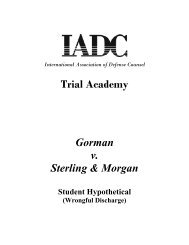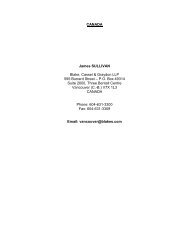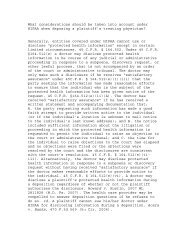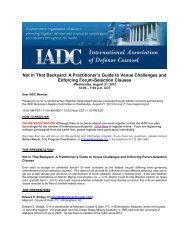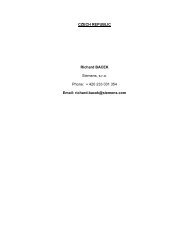Defense Counsel Journal - International Association of Defense ...
Defense Counsel Journal - International Association of Defense ...
Defense Counsel Journal - International Association of Defense ...
Create successful ePaper yourself
Turn your PDF publications into a flip-book with our unique Google optimized e-Paper software.
Page 450 DEFENSE COUNSEL JOURNAL–October 2012discovery had permitted thefactual pleading sought byplaintiffs. In the alternative, thosedefendants would continuallyseek leave to amend and theCourt’s and parties’ resourceswould be wasted. This coursewould also necessitate additionaldiscovery and likely lengthen thetime until a matter could bebrought to trial. That result issimply untenable. 73One recent District Court decisionconsidering a Rule 12(f) motion to strikeopenly wondered “how much energy andexpense was invested in the filing <strong>of</strong>, andopposition to, the instant Motion, whichenergy and expense could better be put tomatters that would advance thedetermination <strong>of</strong> the merits <strong>of</strong> the case.” 74Thus, for any court interested inminimizing potential disputes andconserving resources, it would be unwiseto apply the heightened pleading standardto affirmative defenses.Forcing a defendant to addaffirmative defenses in a piecemealfashion as discovery progresses wouldrequire numerous motions to amend,which plaintiffs likely would oppose. Theargument flows, then, that applying the73 Schlottman v. Unit Drilling Co., LLC, No.Civ-08-1275-C, 2009 WL 1764855, *2 (W.D.Okla. June 18, 2009); see also Brossart, 2011WL 5374446 at *2 (citing Wells Fargo & Co.v. United States, 750 F. Supp.2d 1049, 1052(D. Minn. 2010)) (applying the heightenedpleading standard to affirmative defenses“would significantly change federal practiceand would likely increase the burden on thefederal courts”).74 See Aros, 2011 WL 5238829 at *3 n.3.heightened pleading standard toaffirmative defenses almost certainlyguarantees discovery disputes and motionpractice, increasing the potential fordiscovery and trial dates to be delayed,with attendant increases in time, money,and effort:Applying Iqbal and Twombly toaffirmative defenses would forcedefendants to plead feweraffirmative defenses and then,after taking discovery, to movethe Court for permission toamend their answers to addaffirmative defenses. Plaintiffswould <strong>of</strong>ten resist those motionson the grounds that the proposedaffirmative defenses would befutile. Thus, another round <strong>of</strong>motion practice would be addedto many cases, increasing theburdens on the federal courts,and adding expense and delay forthe parties. 75As a practical matter, even when adefendant lists a large number <strong>of</strong>affirmative defenses, those that areclearly not viable later on simply will notbe pursued. 76 Parties are generally aware<strong>of</strong> the viability <strong>of</strong> listed defenses asdiscovery progresses, and there is little tobe gained by striking defenses even ifthey are technically inappropriate. 77 Not75 Wells Fargo, 750 F. Supp.2d at 1052.76 See id. at 1051-1052 (“In a typical case, itquickly becomes apparent that most <strong>of</strong> theaffirmative defenses are not viable, and theparties simply ignore them. No judicialintervention is necessary.”).77 See Cassetica S<strong>of</strong>tware, Inc. v. ComputerSciences Corp., No. 11 C 2187, 2011 WL



